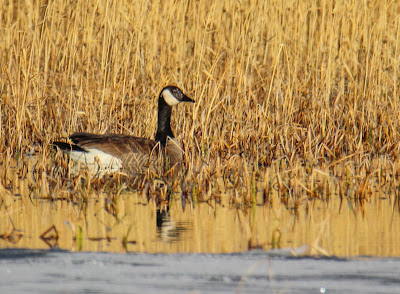As a young boy I remember going to the Bear River Migratory Bird Refuge outside of Brigham City, Utah (60 miles north of Salt Lake City) with an elementary school group and I kept (and may still have) a list of birds found there. I have a vague recollection of cattails and seeing some flying ducks. I have thought of going back many times over the years, but just recently did so.
The refuge is huge, 70,000 acres (by contrast the Salton Sea Sonny Bono NWR is 2,200 acres, Lower Klamath NWR is 57,531 acres, the Tule Lake NWR is 39,116 acres and the Humboldt Bay NWR is just under 4,000 acres), and includes the last ten miles of the Bear River and its delta where it flows into the northern portion of the Great Salt Lake.
 |
| This map of the Bear River watershed from Wikipedia shows the Bear River originating in the Uinta Mountains of northeastern Utah, flowing up through Wyoming and Idaho and back drown through northern Utah where it empties into the Great Salt Lake. |
It includes open water, mudflats, wetlands (freshwater - 41,000 acres, brackish and alkali) and uplands (5,000 acres of grass and forb species). 67 species of birds nest there, including the largest colony of white-faced ibis in North America The James V. Hansen Wildlife Education Center, which opened in 2006, is found right off the I-15 freeway and West Forest Street and it includes a one-half mile wetland walking trail. I did not visit this part of the refuge. But 12 miles further west down West Forest Street is a one-way 12 mile Auto Route, which I did do (36 miles total - 12 miles to get there, the 12 mile loop, then 12 miles to get back). It follows the edge of the North Bay for a short distance, then goes around a portion of the South Bay and crosses the South Bay on a dike.
 |
| The green line outlines the refuge boundary. The Bear River comes in from the northeast and West Forest Road gives several glimpses of it on the way in. The 12 mile auto route is outlined in red. That is the only part of the refuge generally open to the public. |
The following photos are from my visit to the Refuge:
I visited again in August 2021 and saw quite a different array of birdlife. Photos of the birds follow:
 |
| American avocet |
 |
| American white pelican |
 |
| Bank swallow |
 |
| Barn swallow |
 |
| Cliff swallow |
 |
| Tree swallow |
 |
| Tree swallow - immature |
 |
| Western grebe |
 |
| Clark's grebe |
 |
| White-faced ibis |
 |
| Black-crowned night heron |
 |
| Double-crested cormorant |
 |
| Franklin's gull - above and below. |
 |
| Great blue heron |
 |
| Great egret |
 |
| Snowy egret |
 |
| Loggerhead shrike |
 |
| Female ring-necked pheasant |
 |
| Swainson's hawk |
 |
| Yellow-headed blackbird |
I visited again on October 1, 2021 and saw a much more limited assortment of wildlife. I saw an American white pelican, red-winged blackbird, American coot, great egret, great blue heron, northern shoveler, mallard, double-crested cormorant, Clark's grebe and western grebe, and a ruddy duck. New birds were a song sparrow and a gadwall.
I visited again on December 20, 2021. There was very limited wildlife. The large ponds in the center were frozen and the canals around the perimeter were largely frozen.
 |
| These men must have been duck hunting. |
The predominant bird was the rough-legged hawk, a first for me.
Another first was Barrow's goldeneye, two beautiful females.
I also saw a pied-billed grebe, several pheasants, some northern shovelers, and two female buffleheads.
I visited on October 21, 2002 and saw American avocets, American coots, Clark's grebes, western grebes, a great blue heron, a rough legged hawk, western meadowlarks, red-winged blackbirds and a European starling on Forrest Road.
 |
| European starling. |
 |
| Greater Yellowlegs |
 |
| Northern harrier |
 |
| Female northern pintail |
 |
| Western meadowlark. I'd never seen one out there before, and this time I saw quite a few. |
 |
| Black-necked stilt |
 |
| Gadwall |
 |
| Swainson's hawk |
 |
| White-faced ibis |
 |
| Burrowing owl |
 |
| California gull |
 |
| Cinnamon teal |
 |
| Killdeer |
 |
| Long-billed curlew |
 |
| Red-breasted merganser |
 |
| Song sparrow |
 |
| Yellow-headed blackbird |
I visited on October 28, 2023 and it was duck hunting season. Hunters were everywhere, including along the Auto Route, and birds were scarce. I saw lots more hunters and boats than birds. I saw a northern harrier before getting to the auto route, a few gulls and a few grebes and lots of coots. I did get a photo of an American kestrel before the Auto Route along the road in. A first for me in that area.













































































The whistler swans in flight are spectacular, especially that second photo where they seem to be one mass. With their long necks stretched to full length, they look very intent on getting somewhere fast.
ReplyDelete